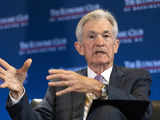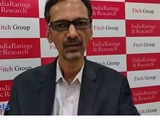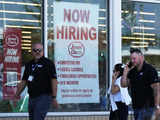Suggest a new Definition
Proposed definitions will be considered for inclusion in the Economictimes.com
Economy
- PREV DEFINITION
- NEXT DEFINITIONUnemployment TrapUnemployment trap is a situation when unemployment benefits discourage the unemployed to go to work.Read More
What is 'Unemployment'
What is unemployment?
The term unemployment refers to a state in which an individual actively seeks employment but is unsuccessful. It is said to be one of the critical measures of the economy's strength. The unemployment rate is the most widely used method to determine a country's unemployment rate. This can be found by simply dividing the number of people without jobs by the total population included in a nation's labor force.
National and local governments often endeavor to offer employment opportunities to certain people who meet the eligibility criteria set by them. Usually, work is availed for groups of individuals upon a fixed minimum wage sufficient for bare survival and provides further chances for them to find permanent jobs. These efforts are made to improve the country's economy and reduce the overall unemployment rate.
Discerning unemployment
Unemployment is a major economic criterion because it shows the capability (or incapability) of healthy, educated, and willing individuals to gain a livelihood. People unable to work for various reasons such as retirement, disability, pursuing higher education, etc., are excluded from this. The higher the country's unemployment rate, its economic growth is less productive.
Even without employment, people still maintain a steady consumption of resources. These resources are merely used up without viable beneficial feedback to the country's economy. As a result, there is a proportional decline in the fundamental economic growth. A constantly high unemployment rate is a significant indicator of financial distress in a country and may have social and political ramifications leading to a degeneration of internal structure.
On the other hand, a low unemployment rate signals maximum use of available labor in an economy, higher wage growth, and an overall increase in living standards. An ideal state for the economy of a country is to have maximum output from its potential workforce. However, a meager unemployment rate is an alert toward an overheating economy, causing inflation and unfavorable situations for employers needing extra labor.
Unemployment is broadly divided into two categories by economists—voluntary and involuntary.
Voluntary unemployment refers to an individual's decision to leave previous employment to look for other forms of work out of their own volition with no external circumstances.
Involuntary unemployment is when an individual loses their job due to various reasons, such as being fired. Their employer is unable to maintain employees and now must look for other sustenance.
What can be the causes of unemployment?
There are many different aspects of the socio-economic system that can be blamed for the cause of unemployment. According to Karl Marx, unemployment is a symptom of the capitalist system. He argued that business people required a larger number of unemployed population to make them eager enslaved people and work for a lesser wage.
Causes of unemployment can be divided into different categories- frictional and structural.
Fictional Unemployment- Frictional unemployment can be defined as a scenario when people leave searching for a better job. In the case of frictional unemployment, it is more voluntary than not. It is natural to have 3-4% in a healthy economy.
Structural employment- Structural employment is when the people's skills and income expectations do not match with the jobs available.
There is also a third category of unemployment known as cyclical unemployment. This is when new people enter the workforce.
Types of Unemployment
Frictional Unemployment: It is a natural consequence of market processes and the exchange of information, which can often be expensive. Finding new employment, hiring the individuals matching the requirements issued by the company, and then giving related jobs to suitable people often leads to frictional unemployment.
Cyclical Unemployment: It refers to the periodic rise and fall in the unemployment rate as an economy undergoes growth and losses. During the recession, unemployment rates soar while they dip substantially when an economy is strong and stable.
Structural Unemployment: It comes about due to changes in the technical skill requirements of jobs that frequently accompany the evolution of society. Often, it is easier to hire new, trained workers than to retrain old workers, resulting in loss of employment for the masses.
Institutional Unemployment: These are the socio-economic reasons for unemployment, including—
Government policies like minimum wages, oppressive job licensing laws, etc.
Discrimination in hiring workers on racial, religious, and other bases.
Labor market institutions like high unionization.
What measures can be taken to alleviate unemployment?
Frictional and cyclical unemployment can be remedied by increasing the number of jobs. Steps can be taken to encourage businesses to hire more people at a better pay rate and promote growth.
Structural employment requires more work and a better long-term solution. Changes should be done from the base level to lower the structural employment rate. Unemployment is a very deep-rooted problem. Changes in the same class include skill training and education. More encouragement towards different fields can help create more jobs and allow the backward part of the economy to flourish more.
What are the different reasons for unemployment?
The different reasons for unemployment include-
Unemployment is a problem because it gives birth to poverty, from individual to national level. Poverty leads to many problems. It also drives people towards focusing less on getting educated and living well and more on getting money. The issue will further lead to exploitation and lesser wages. On a country level, this also leads to one country getting under debt on an international level.
Disclaimer: This content is authored by an external agency. The views expressed here are that of the respective authors/ entities and do not represent the views of Economic Times (ET). ET does not guarantee, vouch for or endorse any of its contents nor is responsible for them in any manner whatsoever. Please take all steps necessary to ascertain that any information and content provided is correct, updated and verified. ET hereby disclaims any and all warranties, express or implied, relating to the report and any content therein.
The term unemployment refers to a state in which an individual actively seeks employment but is unsuccessful. It is said to be one of the critical measures of the economy's strength. The unemployment rate is the most widely used method to determine a country's unemployment rate. This can be found by simply dividing the number of people without jobs by the total population included in a nation's labor force.
National and local governments often endeavor to offer employment opportunities to certain people who meet the eligibility criteria set by them. Usually, work is availed for groups of individuals upon a fixed minimum wage sufficient for bare survival and provides further chances for them to find permanent jobs. These efforts are made to improve the country's economy and reduce the overall unemployment rate.
Discerning unemployment
Unemployment is a major economic criterion because it shows the capability (or incapability) of healthy, educated, and willing individuals to gain a livelihood. People unable to work for various reasons such as retirement, disability, pursuing higher education, etc., are excluded from this. The higher the country's unemployment rate, its economic growth is less productive.
Even without employment, people still maintain a steady consumption of resources. These resources are merely used up without viable beneficial feedback to the country's economy. As a result, there is a proportional decline in the fundamental economic growth. A constantly high unemployment rate is a significant indicator of financial distress in a country and may have social and political ramifications leading to a degeneration of internal structure.
On the other hand, a low unemployment rate signals maximum use of available labor in an economy, higher wage growth, and an overall increase in living standards. An ideal state for the economy of a country is to have maximum output from its potential workforce. However, a meager unemployment rate is an alert toward an overheating economy, causing inflation and unfavorable situations for employers needing extra labor.
Unemployment is broadly divided into two categories by economists—voluntary and involuntary.
Voluntary unemployment refers to an individual's decision to leave previous employment to look for other forms of work out of their own volition with no external circumstances.
Involuntary unemployment is when an individual loses their job due to various reasons, such as being fired. Their employer is unable to maintain employees and now must look for other sustenance.
What can be the causes of unemployment?
There are many different aspects of the socio-economic system that can be blamed for the cause of unemployment. According to Karl Marx, unemployment is a symptom of the capitalist system. He argued that business people required a larger number of unemployed population to make them eager enslaved people and work for a lesser wage.
Causes of unemployment can be divided into different categories- frictional and structural.
Fictional Unemployment- Frictional unemployment can be defined as a scenario when people leave searching for a better job. In the case of frictional unemployment, it is more voluntary than not. It is natural to have 3-4% in a healthy economy.
Structural employment- Structural employment is when the people's skills and income expectations do not match with the jobs available.
There is also a third category of unemployment known as cyclical unemployment. This is when new people enter the workforce.
Types of Unemployment
Frictional Unemployment: It is a natural consequence of market processes and the exchange of information, which can often be expensive. Finding new employment, hiring the individuals matching the requirements issued by the company, and then giving related jobs to suitable people often leads to frictional unemployment.
Cyclical Unemployment: It refers to the periodic rise and fall in the unemployment rate as an economy undergoes growth and losses. During the recession, unemployment rates soar while they dip substantially when an economy is strong and stable.
Structural Unemployment: It comes about due to changes in the technical skill requirements of jobs that frequently accompany the evolution of society. Often, it is easier to hire new, trained workers than to retrain old workers, resulting in loss of employment for the masses.
Institutional Unemployment: These are the socio-economic reasons for unemployment, including—
Government policies like minimum wages, oppressive job licensing laws, etc.
Discrimination in hiring workers on racial, religious, and other bases.
Labor market institutions like high unionization.
What measures can be taken to alleviate unemployment?
Frictional and cyclical unemployment can be remedied by increasing the number of jobs. Steps can be taken to encourage businesses to hire more people at a better pay rate and promote growth.
Structural employment requires more work and a better long-term solution. Changes should be done from the base level to lower the structural employment rate. Unemployment is a very deep-rooted problem. Changes in the same class include skill training and education. More encouragement towards different fields can help create more jobs and allow the backward part of the economy to flourish more.
What are the different reasons for unemployment?
The different reasons for unemployment include-
- Lack of In-demand skills.
- Lack of excess or opportunities This includes Illiteracy, language proficiency, transportation, childcare expenses, and many more
- Lack of skilled jobs. With changing times, the job availability rates are changing as well. The use of AI has resulted in businesses looking for more specific skills.
- Lack of employability. With the need for more jobs, there need to be more employers and businesses.
Unemployment is a problem because it gives birth to poverty, from individual to national level. Poverty leads to many problems. It also drives people towards focusing less on getting educated and living well and more on getting money. The issue will further lead to exploitation and lesser wages. On a country level, this also leads to one country getting under debt on an international level.
Disclaimer: This content is authored by an external agency. The views expressed here are that of the respective authors/ entities and do not represent the views of Economic Times (ET). ET does not guarantee, vouch for or endorse any of its contents nor is responsible for them in any manner whatsoever. Please take all steps necessary to ascertain that any information and content provided is correct, updated and verified. ET hereby disclaims any and all warranties, express or implied, relating to the report and any content therein.
- PREV DEFINITION
- NEXT DEFINITIONUnemployment TrapUnemployment trap is a situation when unemployment benefits discourage the unemployed to go to work.Read More
Related News
 Will volatile US data fuel Fed rate uncertainty? Anurag Singh answersSo, I understand they have room to cut, but I think broadly, all they have is about 150 basis points, that is all there is on the table. Now, my sense is they will take next six meetings to do a 25 basis point each if the data continues to be favourable and stop somewhere at maybe 3, 3.5, so that is broadly the best the market can expect. We are not going back to zero days and I think there are a lot of reasons that we can discuss about.
Will volatile US data fuel Fed rate uncertainty? Anurag Singh answersSo, I understand they have room to cut, but I think broadly, all they have is about 150 basis points, that is all there is on the table. Now, my sense is they will take next six meetings to do a 25 basis point each if the data continues to be favourable and stop somewhere at maybe 3, 3.5, so that is broadly the best the market can expect. We are not going back to zero days and I think there are a lot of reasons that we can discuss about. How fast will interest rates fall? Fed Chair Powell may provide clues in high-profile speechWyoming - With the Federal Reserve considered certain to start cutting its benchmark interest rate next month, Chair Jerome Powell's highly anticipated speech Friday morning at an economic conference will be closely watched for any hints about how many additional rate cuts might be in the pipeline.
How fast will interest rates fall? Fed Chair Powell may provide clues in high-profile speechWyoming - With the Federal Reserve considered certain to start cutting its benchmark interest rate next month, Chair Jerome Powell's highly anticipated speech Friday morning at an economic conference will be closely watched for any hints about how many additional rate cuts might be in the pipeline. Bharat improving and India lagging in consumption? Devendra Pant on state of economyDevendra Pant, Chief Economist at India Ratings, discusses the shift in FMCG companies' concerns from rural India to urban demand. Despite steady GST collections and stable unemployment rates, challenges like food inflation and consumer sentiment issues persist. The government projects GDP growth of 6.5-7% for FY25, cautiously optimistic about inflation.
Bharat improving and India lagging in consumption? Devendra Pant on state of economyDevendra Pant, Chief Economist at India Ratings, discusses the shift in FMCG companies' concerns from rural India to urban demand. Despite steady GST collections and stable unemployment rates, challenges like food inflation and consumer sentiment issues persist. The government projects GDP growth of 6.5-7% for FY25, cautiously optimistic about inflation. 818,000 job loss could be a major problem for Kamala HarrisThe decreasing amount of employment opportunities in the United States is major headache for the remaining months of the Biden administration as well as Kamala Harris as it would become increasingly tough to convince Americans that Democrats are the right fit for the White House amid such a major job recession.
818,000 job loss could be a major problem for Kamala HarrisThe decreasing amount of employment opportunities in the United States is major headache for the remaining months of the Biden administration as well as Kamala Harris as it would become increasingly tough to convince Americans that Democrats are the right fit for the White House amid such a major job recession. What to look for at Fed's Jackson Hole symposiumCentral bankers from around the world fly into Jackson Hole, Wyoming, this week to attend what has become the globe's premier economic gathering, the Kansas City Federal Reserve's annual symposium in Grand Teton National Park.
What to look for at Fed's Jackson Hole symposiumCentral bankers from around the world fly into Jackson Hole, Wyoming, this week to attend what has become the globe's premier economic gathering, the Kansas City Federal Reserve's annual symposium in Grand Teton National Park. Highest in a decade: More than 28% Americans are looking for a new jobAt its highest level in a decade, over 28% of Americans are looking for work, a sign of a more pessimistic view of the economy despite other data pointing to a more stable situation.
Highest in a decade: More than 28% Americans are looking for a new jobAt its highest level in a decade, over 28% of Americans are looking for work, a sign of a more pessimistic view of the economy despite other data pointing to a more stable situation. "BJP brought Haryana to the top in unemployment, drug addiction, crime, corruption": Congress MP Deepender HoodaWith the political lashing heating up following the announcement of the dates for the assembly polls in Haryana, Congress MP Deepender Singh Hooda said that the BJP had derailed the state from the track of development and "brought Haryana to the top in the country in unemployment, drug addiction, crime, and corruption."
"BJP brought Haryana to the top in unemployment, drug addiction, crime, corruption": Congress MP Deepender HoodaWith the political lashing heating up following the announcement of the dates for the assembly polls in Haryana, Congress MP Deepender Singh Hooda said that the BJP had derailed the state from the track of development and "brought Haryana to the top in the country in unemployment, drug addiction, crime, and corruption." "BJP brought Haryana to the top in unemployment, drug addiction, crime, corruption": Congress MP Deepender HoodaWith the political lashing heating up following the announcement of the dates for the assembly polls in Haryana, Congress MP Deepender Singh Hooda said that the BJP had derailed the state from the track of development and "brought Haryana to the top in the country in unemployment, drug addiction, crime, and corruption."
"BJP brought Haryana to the top in unemployment, drug addiction, crime, corruption": Congress MP Deepender HoodaWith the political lashing heating up following the announcement of the dates for the assembly polls in Haryana, Congress MP Deepender Singh Hooda said that the BJP had derailed the state from the track of development and "brought Haryana to the top in the country in unemployment, drug addiction, crime, and corruption." Unemployment rate down a tad in Q1 FY25: DataThe National Statistical Office reported a drop in India's urban unemployment rate for those above 15 years to 6.6% in the April-June quarter FY25, down from 6.7% the previous quarter. Male unemployment decreased, while female joblessness rose to 9%. Youth unemployment also fell, and shares of salaried and casual workers saw an increase.
Unemployment rate down a tad in Q1 FY25: DataThe National Statistical Office reported a drop in India's urban unemployment rate for those above 15 years to 6.6% in the April-June quarter FY25, down from 6.7% the previous quarter. Male unemployment decreased, while female joblessness rose to 9%. Youth unemployment also fell, and shares of salaried and casual workers saw an increase. Why these economic indicators could spell trouble for Donald Trump?Will Republican candidate Donald Trump be able to upset Democrat Kamala Harris's winning equation by taking the rants of "America First" and "Make America Great Again" (MAGA) to a new height? How will economics play an important role in the US Presidential Election 2024?
Why these economic indicators could spell trouble for Donald Trump?Will Republican candidate Donald Trump be able to upset Democrat Kamala Harris's winning equation by taking the rants of "America First" and "Make America Great Again" (MAGA) to a new height? How will economics play an important role in the US Presidential Election 2024?
Load More